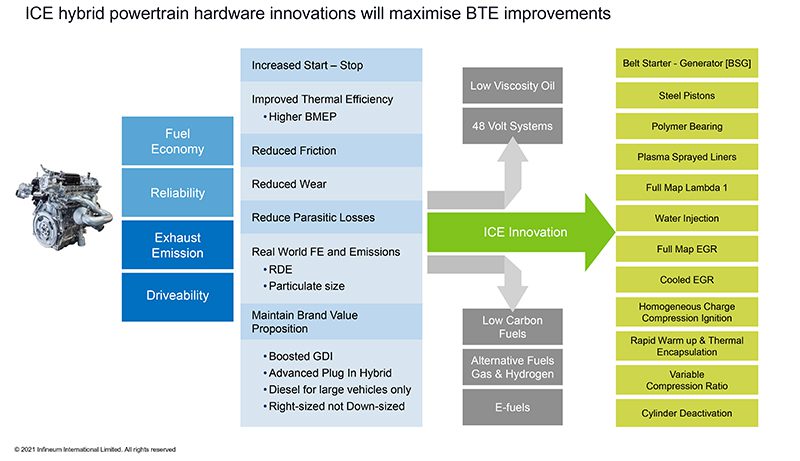Lubricants for hybrids
Lubricants for hybrids – In the automotive industry’s quest for zero-emissions, the pace of vehicle electrification is accelerating and a new class of internal combustion engine technologies with hybrid powertrains is emerging. The authors of this article explore how these ‘electrified ICEs’ (e-ICEs) are increasingly creating a need for lubricants specifically designed to protect hardware, including new aftertreatment systems, and to handle special hybrid operating duty cycles.
The demise of the internal combustion engine (ICE) and switch to full battery electric vehicle (BEV) production is certainly one possible long-term outcome as the automotive industry works towards zero emissions. However, in the near-term, the vehicle powertrain production mix will be spread across many propulsion systems; from the conventional ICE-only, through various degrees of hybridization, to full BEV and fuel cell electric vehicles.
Production of these hybrid vehicle types is projected to grow at a faster rate than BEVs in this decade. Taking a holistic approach to future hybrid powertrains, with multiple innovation options to improve and optimize their efficiencies, including the use of larger volumes of sustainable low carbon fuels, they may well present a viable challenge to the case for the BEV. This new class of e-ICE increasingly creates a need for lubricants specifically designed to protect the hardware, including new aftertreatment systems, and to handle the special hybrid operating duty cycles. In addition, standardized lubricant test methods will be required to meet the needs of the expanding e-ICE powertrain segment.
Five different types of vehicle electrification architectures are considered here, which comprise different ICE and motor propulsion mixes.
Click on the image that follows and read the article “A new generation of lubricants for hybrids” in the digital magazine “LUBES EM FOCO – issue 85” :
Forecasts through to 2029 vary widely on the uptake of the various architectures but show rapid rises in the production of both EV and the main hybrid powertrains.
By 2029, the annual combined production of BEV and hybrids will be over 65% of the total, significantly outpacing ICE-only units, which includes the ICE Stop/Start (microhybrid) category. This latter category may shrink even further if the adoption of 48V powertrain architectures expands the mild-hybrid segment at the expense of the Stop/Start segment.
These projections translate over the 2029 timeframe to a vehicle parc of almost 250 million units of Mild-, Full-, and Plugin- (MFP) hybrids. Fuel cell electric vehicle systems are expected to grow very slowly.
While the likelihood of an accelerated path to full electrification helps cement the view that the pace of ICE innovations will dramatically slow, there is a counter argument that a new generation of e-ICE (hybrid) powertrains will emerge. These will provide better solutions for the growing MFP hybrid segments, particularly if the ICE-only and e-ICE segments share these technologies and exploit synergies. Innovated e-ICEs for dedicated hybrid engines, delivering brake thermal efficiencies, which may approach 50% and meet tightening emissions targets will be paired with targeted hybrid duty cycles.
As the control of particulate counts and sizes becomes more important, it is now almost certain that MFP hybrids will require aftertreatment mixed brick combination devices comprising three-way catalysts, gasoline particulate filters, and possibly NOx and hydrocarbon traps. These innovative combustion engine – hybrid – aftertreatment (e-ICEHAT) solutions will need to make the case for commercialization over BEVs judged by the output of rigorous cradle to grave Life Cycle Assessments (LCAs). The increasing production of renewable and regenerative fuels to power these e-ICEs will strengthen the case for e-ICE-HATs over BEVs, placing them at the center of future technology roadmaps, which include the ICE rather than eliminate it. A summary of the numerous opportunities for ICE hybrid powertrain hardware innovations provides an outline for a future technology roadmap(Figure 2).

In summary, electrification enables ICE advancements (e-ICE) and the role of the lubricant is central to stretching the LCA application targets. This future generation of MFP lubricants can be thought of as e-Lubes if that helps move the discussion forward.










